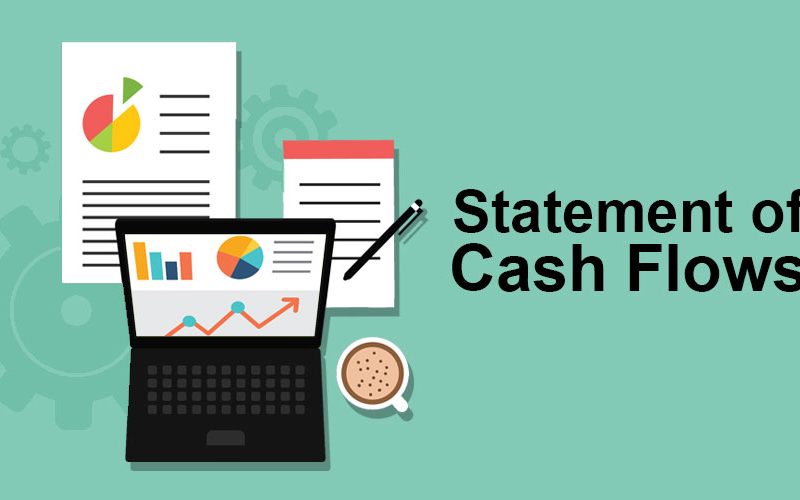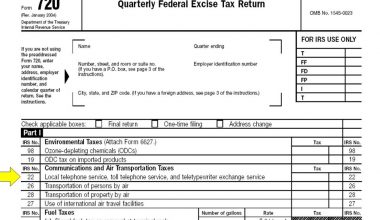It will be a terrible thing not to know when money is entering and leaving in your business. Firstly, We’ll discuss the statement of cash flows, then the indirect method, example, and accounting statement of cash flows.
Statement of Cash Flows
Statement of cash flows is the periodical financial statement that shows the amount you have on hand at any given time. Moreover, the cash flow statement adjusts the information on your income statement. So that you can view your net cash flow which is the exact sum of funds you have on hand for that particular period.
To further explain the above, Depreciation, for instance, is documented as a monthly expense. But, you have already paid money for the property you are depreciating; you document it on a monthly basis to see how much it costs you to have the property each month over its service life. However, cash does not literally leave your bank account every month.
The cash flow statement reverses that monthly expense, allowing you to see how much cash you have on hand in actuality rather than how much you’ve spent in theory.
Need for Cash Flows Statement
Cash flow statements are an integral aspect of financial analysis as long as you utilize accrual accounting for the following reasons:
They Demonstrate Your Liquidity
That shows that you know precisely how much cash flow you have available in case you need it. So you realize what you can and cannot afford.
Show changes in Resouces
They display changes in resources, liabilities, and equity as cash withdrawals, cash inflows, and cash kept. These three categories constitute the foundation of your company’s bookkeeping. Moreover, They constitute the accounting equation, which allows you to evaluate your productivity.
They Allow You To Forecast Future Cash Flows
Cash flow statements can be used to generate cash flow projections, allowing you to forecast how much liquidity your company will have in the future. This is critical when developing long-term company plans.
Furthermore, if you intend to apply for a loan or line of credit, you will need to provide up-to-date cash flow statements.
Cash Flows Statement Indirect Method
The indirect method involves looking at the transactions on your income statement and then reversing some of them to determine your working capital. With the indirect method, you’re selectively retracing your income or cash flow statement to remove transactions that don’t demonstrate cash movement.
Many small firms prefer the cash flows statement indirect method since it is easier than the direct way. You also don’t have to go back and balance your statements with the direct method while using the indirect method.
Statement of Cash Flows Example
The following is an example of a statement of cash flows, often known as a cash flow statement or SCF. (Both the firm and the numbers shown are fictitious.)
The Example of cash flows statement: sum (300,000) indicates that $300,000 in cash was paid out, was a financial outflow, or lowered the company’s cash balance.
The quantity 40,000 denotes that cash in the amount of $40,000 was received, represented a cash inflow, or improved the company’s cash balance.
The cash (260,000) is used for investing purposes. The cash is the sum of the (300,000) cash inflow and the 40,000 cash outflow.
The figure 92,000 is the net cash increase for the year is the total of each section: 262,000 + (260,000) + 90,000. Because this net amount or grand total is positive,
It is important to note that the net growth (or net drop) in cash over the year increases the cash at the start of the year to calculate the cash at the end of the year. In our case, 92,000 + 101,000 equals $193,000. The $193,000 end-of-year balance should correspond to the cash balance on the company’s balance sheet as of December 31, 2020. The above is an example of a cash flows statement.
The Accounting Statement of Cash Flows
An accounting statement of cash flows is a financial statement in financial accounting that demonstrates how changes in balance sheet accounts and income influence cash and cash equivalents. And further divides the analysis further to operating, investing, and financing activities.
Sections of Accounting Cash Flows Statement
The sections of the accounting cash flows statement include the following;
Cash Flows from Operating Activities
This section reflects an overview of cash receipts and cash payments from operations. As well as the modifIcation in cash as a result of everyday activities. Furthermore, It is the difference between the amount of money collected from customers and the amount of money paid to suppliers and employees. Finally, It also contains interest paid and dividends received on securities held by the company.
Cash Flows from Investing Activities
This chapter analyses the cash transaction for the purchase and sale of fixed assets and investments. as well as the change in cash due to investments and disinvestments. such as transactions involving financial lengthy assets such as notes receivable.
Cash Flows from Financing Activities
This section summarizes the cash transactions connected to the business’s equity financing and borrowings. as well as the cash change over the course of acquiring and repaying loans, issuing shares, repurchasing shares, and paying dividends.
What Is the Aim of a Cash Flows Statement?
The cash flow statement combines information from the income statement and balance sheet to provide information about a company’s cash sources and uses over a certain time period. Moreover, The cash flow statement can be use to assess a company’s liquidity and long-term solvency.
Secondly. the cash flows statement eliminates non-monetary activities from the income statement, such as depreciation expenditure for equipment. This provides further information on which parts of the firm generate cash. In addition, The cash flow statement is also useful because the income statement cannot illustrate the flow of cash. Since it is made on an accrual basis.
Finally, many people believe the cash flow statement to be less essential than the income statement or the balance sheet. But then it is the only one of the three that can truly be used to analyze a company’s financial trends. It is also a highly important statement when selling a company since it gives the acquirer the information needed. In order to support the business’s ability to finance the list price through cash producing from operations.
What Is the Purpose of the Cash Flow Statement?
The CFS enables investors to understand how a company’s operations work, where its money comes from, and how it is spent. Moreover, the CFS is significant because it assists investors in determining whether a company is financially stable.
Creditors, on the other hand, can use the CFS to calculate how much cash is available (referred to as liquidity) for the firm to fund operating expenses and pay off debts.
The Cash Flow Statement’s Structure
The following are the primary components of the cash flow statement:
Revenue from operating activities
Profits from investment activities
Cash generated by financing operations
Non-cash activity disclosure, which is occasionally included when produced in accordance with generally accepted accounting principles (GAAP)
The CFS differs from the income statement and balance sheet in it. Moreover, it does not reflect the amount of future incoming and outgoing cash that has been reported as revenues and costs. As a result, cash is not the same as net income, which includes both cash and credit sales on the income statement.
Revenue from Operating Activities
Any sources and expenditures of cash from business activities are included in the CFS’s operating activities. In other words, it indicates the amount of money earned by a company’s products or services.
Among these operational actions could be:
- Revenue from the sale of products and services
- Payments of interest
- The payments of income taxes
- Payments made to providers of goods and services used in the manufacturing process
- Employee salary and wage payments
- Payments for rent
- Expenses for any other form of operation
Receipts from the sale of loans, debt, or equity instruments are included in the case of a trading portfolio. Or an investment firm because it is a business activity.
Profits from Investing Activities
Investing operations encompass all sources and uses of cash generated by a company’s investments. Hence, this category includes the purchase or sale of an asset, loans paid to suppliers or received from consumers, and payments associated to a merger or acquisition. In a nutshell, changes in equipment, assets, or investments are related to cash from investments.
Changes in cash from investing are typically classified as a “cash-out” item since cash is used to purchase new equipment, buildings, or short-term assets such as marketable securities. Moreover, when a corporation sells an asset, the transaction is called “cash-in” for the purposes of calculating cash from investing.
What Is Statement of Cash Flow Statement?
A cash flow statement is a type of financial statement that presents total information on all cash inflows a business makes from ongoing activities and outside sources. It also includes any cash outflows made within a specific time period to cover investments and business expenses.
How and Where Are Cash Flow Statements Used?
By monitoring an organization’s cash flow, a cash flow statement is a crucial tool for managing finances. This report is one of the three crucial ones that determine a company’s performance, together with the income statement and the balance sheet.
What Makes Cash Flow Crucial?
Cash flow is crucial because it makes it possible for you to both fulfill your current financial responsibilities and make plans for the future. Cash flow, however, is a problem that many small firms face.
What Is the Objective of a Cash Flow Statement?
The Statement of Cash Flow’s purpose is to give a thorough account of how and how much money is coming into and going out of the company. It describes how the money was made and then utilized during a specific accounting period.
What Is the Most Important Cash Flow?
Operating cash flow (OCF) is a company’s lifeblood and possibly the most significant indicator investors have for assessing corporate health. Operating cash flow is frequently seen as a more accurate indicator of a company’s financial health for two key reasons, despite the fact that many investors favor net income.
Is Cash Flow an NPV?
The present value of each cash flow over the course of a project is used to compute NPV. The initial investment in the investment is then deducted from the present value of the cash flows. The project will be financially successful if the difference is positive (higher than 0).
Is Cash Flow and NPV the Same?
They aren’t the same, though. You can assess the present value of predicted cash flows using the discounted cash flow analysis. After deducting startup expenditures, the Net Present Value reveals the net return on your investment.
Is Cash Flow a Debt?
The ratio of an organization’s operating cash flow to its total debt is known as the cash flow-to-debt ratio. This ratio, which is a sort of coverage ratio, can be used to estimate how long it would take a business to pay off all of its debt if it used all of its cash flow for that purpose.
How Do You Know if Cash Flow Is Good?
Monitoring free cash flow across several time periods and comparing the results to businesses in the same industry is crucial. A corporation should be able to meet its obligations, including supporting its operating activities and paying dividends, if free cash flow is positive.
Is Cash Flow an Asset?
A company’s overall cash from all of its assets is referred to as cash flow from assets. It establishes how much cash a company spends on operations over a certain time frame. It does not, however, take into account funds from alternative funding sources, such as the sale of stocks or debt to make up for negative cash flow from assets.
Conclusion
With the above, you can see the need for a statement of cash flows
Statement of cash flows FAQ
What are the three types of statement of cash flows?
- Operating activities – Cash activities related to net income
- Investing activities – Cash activities related to non-current assets
- Financing activities – Cash activities related to non-current liabilities and owner’s equity
What Does A Cash Flows Statement Do?
The cash flows statement shows the inflows and outflows of cash. Inflows include business sales, income or revenues, and outflows which include any payments like inventory, rent, etc
How Do You Calculate Cash Generated From Operations?
To find the amount of cash flow that was generated from operations using the cash flow statement use the equation Cash generated from operations = Net income + Non-cash Expenses + Changes in Working Capital
Who Uses Cash Flow Statements?
Business owners, accountants, bankers, and buyers of businesses use the components of the cash flow statement to analyze the cash generation and cash inflows, and cash outflows of a company. It is also used to analyze the liquidity and long term solvency of a company
- Stock Valuation: Overview, & Effective Valuation Methods
- COMPANY VALUATIONS: Methods, Definition, and Importance of Valuations
- Cash Flow Statement Indirect Method: Overview, Examples, Calculations
- Balance Sheet vs. Income Statement: Examples, Differences & Relationship
- Cash Flow Statement Direct Method: Overview, Examples, Pros & Cons
- CAPITAL CONTROLS: BEST PRACTICES WITH PRACTICAL EXAMPLES






